Monday, August 17 2015
There is some concern that the drought in California has led to an increase in rattlesnake bites across the state. Along with many 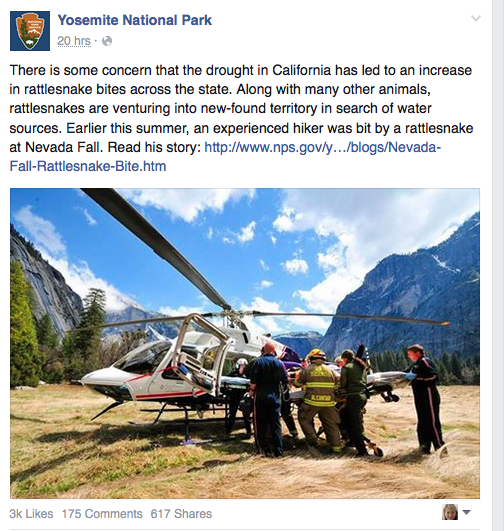 other animals, rattlesnakes are venturing into new-found territory in search of water sources. Earlier this summer, an experienced hiker was bit by a rattlesnake at Nevada Fall. The story was posted today on Facebook with a link to the Yosemite National Park website. Below is an excerpt: other animals, rattlesnakes are venturing into new-found territory in search of water sources. Earlier this summer, an experienced hiker was bit by a rattlesnake at Nevada Fall. The story was posted today on Facebook with a link to the Yosemite National Park website. Below is an excerpt:
On June 29, 2015, sometime around 4 pm, a 49-year-old day hiker at the top of Nevada Fall experienced what many people would consider their worst nightmare: being bitten, and envenomated, by a rattlesnake. He was an experienced hiker and had come across rattlesnakes in the wild before.
The top of Nevada Fall was the objective for the subject and his family. Upon reaching the footbridge at the top of the fall, they decided to do what many hikers feel the need to do after walking in the afternoon heat: take off their shoes and cool their feet at a safe spot in the river. As the subject made his way back onto the granite shoreline, he stepped down into a shallow recess between several rocks and was immediately bitten on the right foot. Moments later, another member of the subject’s family dialed 911 and reported the incident, at which time Yosemite Search and Rescue began to mobilize their response.
A rescue team began hiking to the patient's location as park helicopter 551 mobilized. Approximately one hour after being bitten, 551 airlifted the subject from the top of Nevada Fall and flown to the valley floor, where medical care was waiting. The clinic staff administered antivenom medication to the subject, stabilized him, and readied him for transport to a regional hospital via a medical helicopter.
Many people see rattlesnakes while hiking in Yosemite. Snake bites are rare here, but it is important to know that they do occur and that the resulting injuries can be serious: this subject spent several days in the hospital recovering from his bite. It is understandable that the patient was barefoot while wading, but for the rest of the hike, a pair of snake boots or other sturdy shoes can protect against many snakebites. Snake gaiters offer snake bite protection from approximately your knee down to your ankle and should be worn with sturdy boots. An important lesson to learn from this incident is to always be aware of where you place your hands and feet—in addition to snakes, crevices can hide scorpions, spiders, and yellow jacket nests. This hiker didn't do anything wrong. In this case it just happened to be that a viper proved to be the most dangerous part of the trip— not the obvious hazards of the quickly flowing river, the granite cliffs, or the midday heat.
If you are bitten, keep in mind that the most effective treatment for snakebite is to seek medical care at a hospital or emergency room as quickly as possible. Gone are the days when snakebite first aid involved cutting into the bite and sucking the venom out of the body. Don't try it! It doesn't work!
Finally, treat all wildlife with respect and give them the space they need to stay wild. Never approach wildlife to feed, pet, or photograph them. No matter how docile the animal or reptile may appear, it is wild and could spook easily.
Monday, August 03 2015
No one knows for sure how many people are actually treated for venomous snakebite annually, but according to a Parks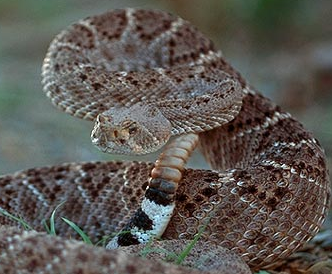 and Wildlife Department herpetologist, each state usually reports of one or two deaths per year. For those bitten who survive, treatment for rattlesnake bites reportedly runs anywhere from about $20,000 at the minimum up into the six-figure range. Anti-venom and treatment is very expensive! Young children out exploring and intoxicated young men make up a good chunk of the bite victims. Hikers and hunters also get bitten, as do those who work in and around snake habitat, especially when moving logs and rock piles. and Wildlife Department herpetologist, each state usually reports of one or two deaths per year. For those bitten who survive, treatment for rattlesnake bites reportedly runs anywhere from about $20,000 at the minimum up into the six-figure range. Anti-venom and treatment is very expensive! Young children out exploring and intoxicated young men make up a good chunk of the bite victims. Hikers and hunters also get bitten, as do those who work in and around snake habitat, especially when moving logs and rock piles.
To keep you and your family safe, it’s important to be aware of your surroundings and to know which venomous snakes you might encounter where you live, work, and play. Texas has the most snake bites annually in the country, usually between 500 and 1,000. One-third to a half of those bites are venomous. Experts in the Lone Star State say you only need to worry about four species: western diamondback rattlesnake, copperhead, coral snake, and cottonmouth (also called water moccasin). Size does not matter because they are venomous at birth.
Coral snakes spend most of their time under leaves and logs and few people ever see them. They really aren’t a threat unless they are handled. Cottonmouths have black and white chins, float on top of the water and are not all that common. The copperhead is the only snake in Texas that is a two-color banded snake. The majority of venomous snakes sighted in residential yards are the diamondback. This rattlesnake sheds within 10 days of being born and then scatters. Babies end up in some strange places, like back steps and garages, looking for mice and lizards to eat, so you’re most likely to see this snake around homes and sheds. Adult diamondbacks want to stay away from activities and people. The most common snakes people encounter that are not poisonous are rat snakes—the only large snake that climbs.
Texas, of course, isn’t the only state with vipers. Oklahoma is home to five species of rattlesnakes. Three venomous species call Pennsylvania home— the northern copperhead, timber rattlesnake, and eastern massasauga rattlesnake. In California, where more than 800 humans are bitten each year, there are at least six types of rattlesnakes to be concerned about. Arizona has 13 species of rattlesnakes, and Nevada has six. Alaska is the only state that has never reported a venomous snake. For a list by state, visit http://www.venombyte.com/venom/snakes/venomous_snakes_by_state.asp
The best suggestions for avoiding snake bite is common sense and prevention. Don’t walk through tall grass. Places like flooded pastures create great breeding sites for frogs and feeding sites for frog hunters like snakes. Walk around rock piles and logs instead of stepping over them. If you see a snake, leave it alone. Remember that snakes are just as active in the fall as they are in the spring, so hunters should be extra cautious. No matter which state you live in, it makes sense to think about snake bite protection in advance of being outdoors — simply wear snake gaiters or snake boots. If you are bitten, below are a few do's and dont's suggested by medical professionals:
What to Do if You Are Bitten by a Snake
- Call 911 immediately.
- Stay as calm as possible.
- Get away from the snake but stay as immobile as possible until help has arrived.
- Remove clothing or accessories that may restrict your blood flow and cause swelling.
What Not to Do if You Are Bitten by a Snake
- Don’t try to capture the snake – this is unnecessary and can lead to a more dangerous situation.
- Don’t create an incision or suction the wound.
- Don’t administer any drugs to the victim.
- Don’t apply a tourniquet (restrictive device used to constrict the flow of blood to a body part).
- Don’t apply ice to the snakebite.
- Don’t wait to see if symptoms occur – seek professional medical help immediately!
Monday, June 08 2015
Some experts say that snake bites are on the rise in some regions such as San Diego and Southern California, due to drought  conditions. Scarce water levels means low moisture content in plants, which in turn attracts fewer rodents, squirrels and rabbits — meaning less prey for snakes— so the vipers are on the move. Wildfires don't help the situation because habitat is disturbed, driving rattlesnakes farther into areas where there are more people. In addition to humans, more dogs have been bitten this spring, leading to more veterinarians giving snakebite vaccines to man’s best friend. And some reports indicate snake venom appears to be getting more toxic. This is worrisome to emergency room doctors who say it seems like vipers are packing a more deadly dose of venom than ever before. conditions. Scarce water levels means low moisture content in plants, which in turn attracts fewer rodents, squirrels and rabbits — meaning less prey for snakes— so the vipers are on the move. Wildfires don't help the situation because habitat is disturbed, driving rattlesnakes farther into areas where there are more people. In addition to humans, more dogs have been bitten this spring, leading to more veterinarians giving snakebite vaccines to man’s best friend. And some reports indicate snake venom appears to be getting more toxic. This is worrisome to emergency room doctors who say it seems like vipers are packing a more deadly dose of venom than ever before.
Other experts believe snakes are not affected by drought because they’ve evolved in areas where droughts are frequent. Their explanation for the increase in bites is because rattlesnakes are more active as daylight hours lengthen. The sun signals their pituitary glands to wake up, get food and find a mate. One park service employee said, "It is like real estate: location, location, location. More people are out on forest trails in spring in summer as schools let out, which leads to more encounters with snakes."
Whatever the reasons, biologists and doctors said agencies need to post more signs explaining how to prevent snakebites. Too many people wear shorts and flip-flops instead of long pants and snake gaiters with boots or sturdy shoes. Also, going off trail and being unable to hear a snake’s rattle because someone’s wearing earbuds with music blaring adds to the possibility of getting bitten. There's a good chance you've been close to a snake while hiking and never knew it. A snake's camouflage allows it to blend into its surroundings. The can be tough to see, so stay alert.
If you encounter a rattlesnake, the way you act will likely determine the experience you have. Like most animals, rattlesnakes fear humans. Give snakes spac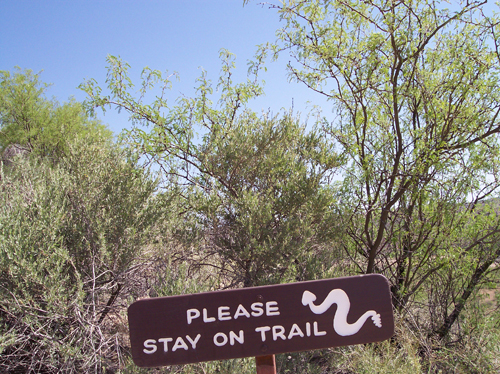 e, watch where you step, and watch where you place your hands when you sit down. Never hike alone, always carry a cellphone, and tell family members where you’re going ahead of time. If bitten, call 9-1-1. Stay calm. Don’t use tourniquets or try to suck out the venom. Get to a hospital as soon as possible. Although 25 percent to 50 percent of rattlesnake bites are dry bites (no venom), you won't know that when you are struck. Treatment for a rattlesnake bite can require up to four of five days in a hospital. e, watch where you step, and watch where you place your hands when you sit down. Never hike alone, always carry a cellphone, and tell family members where you’re going ahead of time. If bitten, call 9-1-1. Stay calm. Don’t use tourniquets or try to suck out the venom. Get to a hospital as soon as possible. Although 25 percent to 50 percent of rattlesnake bites are dry bites (no venom), you won't know that when you are struck. Treatment for a rattlesnake bite can require up to four of five days in a hospital.
If you encounter a rattlesnake while hiking, it is recommended that you do the following:
- Remain calm. Do not panic.
- Stay at least five feet from the snake. Give the rattlesnake plenty of space.
- Do not try to kill the snake. Doing so is illegal in some states (Utah is a good example) and greatly increases the chance the snake will bite you. Most venomous bites happen when untrained people try to kill or harass a snake. Usually the snake is simply moving through the area, sunning itself or looking for a place to hide. If you leave the snake alone, it will leave you alone.
- Alert other people to a snake's location. Advise them to use caution and to respect the snake. Keep children and pets away.
It is a myth that smaller rattlesnakes give more venom than adult snakes, but no matter the age or size, rattlesnakes are the most dangerous snakes in the world because they actually inject venom into you. Other species may bite and it is a grinding bite. Rattlesnakes, however, have hollow teeth with venom glands that act like a plunger in a hypodermic needle. With months of hot weather ahead, the number of snake bite victims easily could rise, especially in areas with droughts and wildfires. These conditions send the vipers scattering for food, which could increase the likelihood of encounters with humans. The best advice is to be prepared. Wear snake bite protection.
Wednesday, April 29 2015
Most rattlesnakes are out of their dens by mid-May, roaming the wild and occasionally alarming humans. The fear of snakes ranks 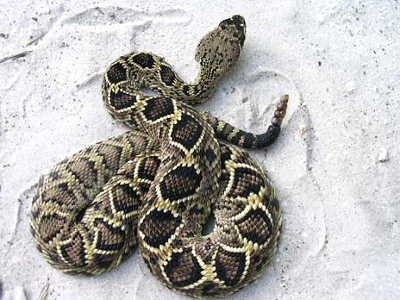 near the top of most common phobia lists, but do people in eastern states need to be worried about serpentine encounters as much as those in western and southern states? near the top of most common phobia lists, but do people in eastern states need to be worried about serpentine encounters as much as those in western and southern states?
Rattlesnakes are considered threatened or endangered in certain states such as Pennsylvania, New York, Ohio, New Jersey, Vermont, New Hampshire and Massachusetts. This particular venomous creature is vulnerable to loss of habitat and being run over by vehicles. Once the population is depressed, it takes the population a long time to recover because of slow reproduction rates. It takes females the first seven to nine years of their 30-year life to reach sexual maturity. They will then only have a litter every three to five years, and only one baby from each litter will likely survive to reach maturity.
Still, snakes are surviving in eastern snakes and whether you should be truly concerned about them while hiking, hunting, or working in your yard depends largely on how often you will be in areas known for snakes. Your best bet is to wear snake gaiters or snake boots while recreating or working in snake habitat. Rattlesnakes are unlikely to bite unless provoked — usually by a young person bitten on the hand because they attempted to pick it up. Children need to realize if you poke at it long enough, even the most docile snake of any species is going to strike. Also, if you startle a snake by accidentally stepping on it, or perhaps moving a rock or piece of wood not knowing a snake is under there, that's when bites can occur, too.
If you happen to get bit, do not cut or suck the wound or use a tourniquet to isolate the venom. Go directly to a medical facility as quickly as possible. Not all hospitals carry anti-venom, so it’s a good idea to call ahead. Some victims might need to be hospitalized. Although a rattlesnake bite can be very painful and expensive (anti-venom doesn't come cheap), it's not common enough to avoid hiking or fishing or otherwise having fun in the woods on a summer’s afternoon. Just be prepared with the right snake bite protection, use common sense, and be on the look-out so you can avoid any rattlers that are also taking advantage of a sunny summer day.
Tuesday, March 31 2015
Most times we want to AVOID snakes, but if you are a gardener, you just might be glad to see the "right" kind of snake gliding through your vegetable plants. The "right" kind of snakes consume a wide variety of garden pests. For example, the garter snake feeds on slugs; the sharp-tailed snake adds grubs to their diet, including the destructive Japanese beetle grub. Rubber boas specialize in eating mice and voles, and will even go down their tunnels after them. And gopher snakes snack on mice and rats.
Garter snakes are the most common type seen by urban and suburban gardeners. Depending on where you live, there are several species of this type of snake, such as the western terrestrial garter, the northwestern garter, and the common garter. Garter snakes generally breed in the spring and give birth to live young in the late summer or fall. The young are not often seen until the following spring, after they emerge from hibernation after their first winter. Most young garter snakes do not survive into adulthood because they are killed off by predators, cars, and lawnmowers.
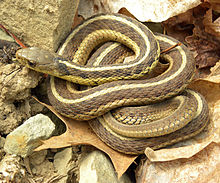 The common garter snake (Thamnophis sirtalis) is, well, the most common species in North America. You can generally recognize it by the pattern of yellow stripes on a brown or green background. Their average total length (including tail) is about 22 inches. The average body weight is only about 5 ounces. In summer, it is most active in the morning and late afternoon; in cooler seasons or climates, it restricts its activity to the warm afternoons. In warmer southern areas, the snake is active year-round; otherwise, it sleeps in common dens, sometimes in great numbers. For humans, a bite is not dangerous, though it may cause slight itching, burning, and/or swelling. The snake's salivia is poisonous to its prey. The common garter snake (Thamnophis sirtalis) is, well, the most common species in North America. You can generally recognize it by the pattern of yellow stripes on a brown or green background. Their average total length (including tail) is about 22 inches. The average body weight is only about 5 ounces. In summer, it is most active in the morning and late afternoon; in cooler seasons or climates, it restricts its activity to the warm afternoons. In warmer southern areas, the snake is active year-round; otherwise, it sleeps in common dens, sometimes in great numbers. For humans, a bite is not dangerous, though it may cause slight itching, burning, and/or swelling. The snake's salivia is poisonous to its prey.
If you have pets, the likelihood of attracting garter snakes is minimal, but if you want to make your garden or lawn garter snake friendly, follow this advice:
• Walk your lawn before you mow it to scare the snakes into hiding. Lawn mowers are deadly to snakes because they can't hear like humans do. Rather, they feel vibrations.
• Provide habitat for snakes if you have room. Old plywood or corrugated metal roofing left loosely on the ground in an out-of-the-way place on your property provides hiking and nesting places for snakes. Old stumps and large rocks also make good snake habitat. Keep in mind that these very habitats can also attract the WRONG kind of snake such as rattlers and other venomous vipers.
• Don't use chemicals such as pesticides and fertilizers in areas used by snakes, including lawns.
Of course rattlesnakes feed on mice, rats, and other small animals that you might want to get rid of, but they are not exactly the type of slithering creature you want to attract! If you live, work, or play in rattlesnake country, wear snake gaiters or snake boots and be safe!
Tuesday, February 03 2015
You might recently have heard on the news that a 14-year-old boy was airlifted out of Mission Trails Regional Park in San Diego, California after a rattlesnake bit his leg. In Arizona, an adult was badly bitten on the knuckle of his middle finger. At the hospital, the man who nearly lost his finger from the bite said, "It felt like having your finger injected with molten lava. The pain was intense and immediate, the swelling was dramatic, almost instantaneous." He had to be treated with 23 vials of costly anti-venom.
Isn't it too early in the season to have to worry about snake bite? Shouldn't these venomous creatures still be hibernating until March or April? Well, that depends. A warmer than expected winter in some places has caused snakes to come out of hibernation earlier than usual. In fact, in warmer southern states, snakes often don't go into hibernation at all. Instead, they go into "brumation."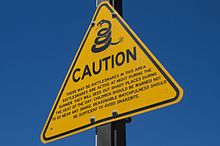
Hibernation is a deep sleep, usually occuring in colder, snow covered climates in northern states. Snakes don't actually sleep in brumation, but their bodies acclimate to a lower temperature, their metabolism slows, and they become less active and less inclined to feed. Brumation or hibernation is necessary for breeding. If male snakes don't cool down at some point during the year, they most likely would not be able to produce fertile sperm.
On warm days, brumating snakes sometimes come out of their dens to bask in the sunshine. Nice sunny winter days are often when people are surprised by snakes. Just like humans, snakes head out to enjoy the sun and unsuspecting hikers can startle them and cause them to strike. As a rule of thumb, rattlesnakes can strike a distance of two-thirds their total body length. That means a three foot long snake may be able to strike a distance of two feet. The best advice is to stay alert when recreating in environments where snakes are known to live. If you see a snake or hear it rattle, take one big step back so you're immediately out of striking range. Rattlesnakes usually try to get way from people and bite only when attacked -- or when they perceive they are being threatened or attacked. Many bites occur when snakes are accidentally stepped on. Wear snake gaiters or snake proof boots and you'll know you're protected in case that happens.
Generally, rattlesnakes emerge from hibernation in March or April, or when the average daytime temperatures reach and remain about 60 degrees Fahrenheit and higher. In the spring, keep in mind that emerging snakes are hungry, thirsty, and ready for love! They are most active in 80-degree temperatures. With spring approaching, follow the Boy Scout motto and be prepared. Whether you are of the mindset that rattlers and other dangerous snakes have their place in the ecosystem and should be left alone when encountered, or think the only good rattler is a dead rattler, don't take a chance. Wear snake gaiters or snake boots and you'll know you're protected when in the desert or woods.
Friday, November 28 2014
When snakes in the wild go into hibernation depends on two things: their location and their species. A snake in Minnesota will go into hibernation much earlier than a snake in Texas, and come out of hibernation much later. Snakes from tropical climates, such as pythons and boas, don't hibernate at all. Venomous snakes from North America, such as rattlers, copperheads, and cottonmouths, hibernate when the weather cools down. Snake activity picks up as temperatures fall in late summer and early autumn before they go into hibernation, which can be as early as September or as late as December. Generally, rattlesnakes emerge from hibernation in March or April, or when the average daytime temperatures reach and remain about 60 degrees Fahrenhei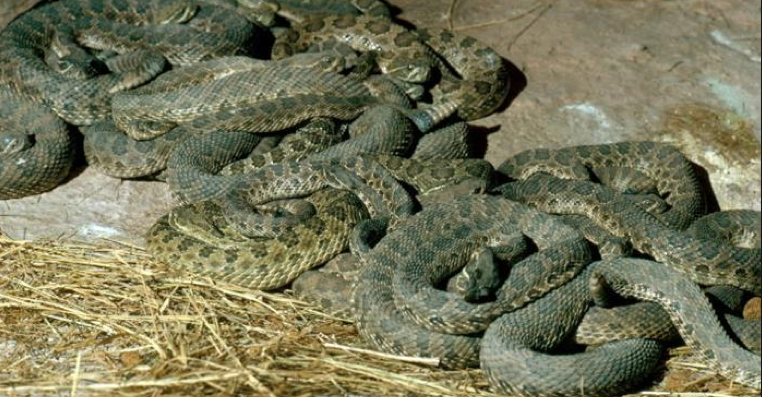 t and higher. t and higher.
In warmer southern states, snakes often don't go into hibernation, but brumation. Hibernation is a deep sleep, usually occuring in colder, snow covered climates in northern states. Snakes don't actually sleep in Brumation, but their bodies acclimate to a lower temperature, their metabolism slows, and they become less active and less inclined to feed. Brumation or hibernation is necessary for breeding. If male snakes don't cool down at some point during the year, they most likely would not be able to produce fertile sperm.
On warm days, brumating snakes sometimes come out of their dens to bask in the sunshine. Nice sunny winter days that follow a long cold snap are often when people are surprised by snakes. Just like humans, snakes head out to enjoy the sun and unsuspecting hikers can startle them and cause them to strike. As a rule of thumb, rattlesnakes can strike a distance of two-thirds their total body length. That means a three foot long snake may be able to strike a distance of two feet. Rattlesnakes cannot jump. If striking downhill, however, gravity and the momentum generated by a strike may combine to carry the animal farther forward than would occur over flat ground. On very steep slopes, a snake could lose balance during a strike and actually fall toward its target. Thus, the effective range of a downhill strike may exceed that normally expected across a level surface.
Caves and deep crevices on rocky hillsides are common hibernaculums for rattlers. Many species hibernate in groups. Rodent burrows are probably the most common places for sleeping snakes, especially in southern states such as Texas. Other places include holes under the roots of a tree or inside a rotting log. Barns or under houses are other good spots for snakes. Not all snakes will survive hibernation. A skinny snake will not survive. If the snake feeds heavily before they hibernate, and have digested their meal before the cooling starts, they will be OK. If food is in their stomach or intestines when they cool, it will rot and kill them.
Snakes are most active whenever temperatures are between 80-90F. This means that the snakes may be active most of the day during the spring, and during the early mornings and late afternoons throughout the summer. Exposure to temperatures above 110F for more than a few minutes is enough to kill a rattlesnake; therefore, during the hottest part of summer, snakes are seldom observed, except occasionally at night. Snake activity picks up again as temperatures begin to fall in late summer and early autumn before they go into hibernation or brumation.
An estimated 45,000 people are bitten by snakes annually in the United States. Approximately 8,000 of these bites are from venomous snakes. It is estimated that snakebites account for 125,000 deaths worldwide each year. Those statistics are enough reason to always wear snake boots or snake gaiters when in snake country, which could be the desert or the woods. If you do, you won't have to worry so much about the temperature or the season because if you use common sense and wear snake bite protection, you'll keep yourself safe.
Saturday, August 02 2014
The unseasonably warm weather is bringing rattlesnakes out of hiding, resulting in larger numbers of people being bitten this spring and summer. And while snakes are found in both dry and wet environments, did you know that wood piles are one of the most common places for rattlers and other snakes to hide? Recently, a victim in San Bernardino County, California was tidying up a wood pile in his back yard. He reached for a log and felt a sudden burning sensation in his arm. Not two weeks l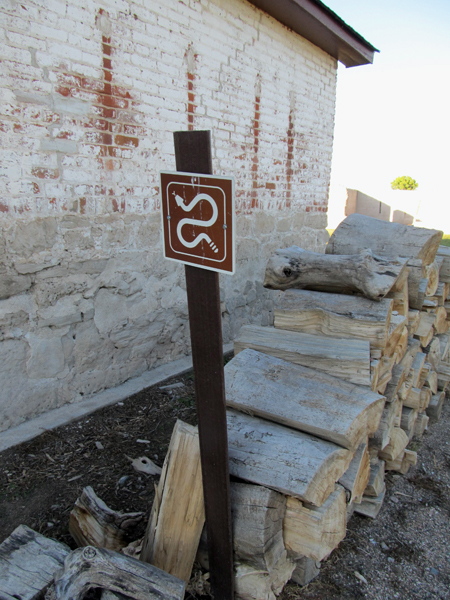 ater, also in southern California, another man building a firewood pile on his property was bitten by a juvenile rattlesnake, later identified as a Southern Pacific rattlesnake, also known as a Western rattlesnake. This particular type of rattlesnake is native to California and has highly toxic venom. The venom of the Southern Pacific rattlesnake is so toxic that it requires more antivenin than other types of rattlesnakes and packs a potentially lethal punch. Wearing protective gloves and snake gaiters on your lower legs is an easy and inexpensive safety precaution when working in snake habitat. ater, also in southern California, another man building a firewood pile on his property was bitten by a juvenile rattlesnake, later identified as a Southern Pacific rattlesnake, also known as a Western rattlesnake. This particular type of rattlesnake is native to California and has highly toxic venom. The venom of the Southern Pacific rattlesnake is so toxic that it requires more antivenin than other types of rattlesnakes and packs a potentially lethal punch. Wearing protective gloves and snake gaiters on your lower legs is an easy and inexpensive safety precaution when working in snake habitat.
Why wood piles? Snakes cozy up in many places— rock walls, ledges, under bushes— but many times snakes live where their food supply is plentiful. Mice and rats like to build their nests in wood piles. Get rid of rodents and you will remove a major source of rattlesnake attractant. This is especially important around areas where animal food is stored on farms. The height of activity for snakes is during summer, and especially at night. If you have woodpiles, you want them 12 to 16 inches above the ground. It doesn't give a place for the snakes to hide.
If a rattlesnake feels threatened it will often times release its venom. The venom can clog your blood and shut down your respiratory system. Rattlesnake venom works like acid in the body, killing the living cells it touches. If you get bitten, it is going to hurt, it is going to swell, and you are going to have tissue damage. If not treated quickly, a bite in the arm or leg could cause irreversible damage to that limb. It is important to keep the wound immobilized below the heart so that the venom spreads less quickly. It is critical to receive immediate medical attention.
Besides the damage and pain that can be caused by a bite, you will likely face high medical expenses. A victim of a rattlesnake bite is given between 10 and 15 anti-venom vials. Each of those vials costs between $2,000 and $5,000! Wearing protective snake gaiters or snake boots is an easy and inexpensive safety precaution for not only working around woodpiles, but when hiking or camping in the desert or woods. Be safe and not sorry— wear snake bite protection!
Sunday, June 22 2014
The official start of summer means more people are generally spending more time outdoors, which also means their dogs are with them, especially when hiking and camping. Rising temperatures can also mean more snakes are active, resulting in the risk of more snake bites for both humans and animals. Of course if you spend a lot of time in "snake country" (could be the de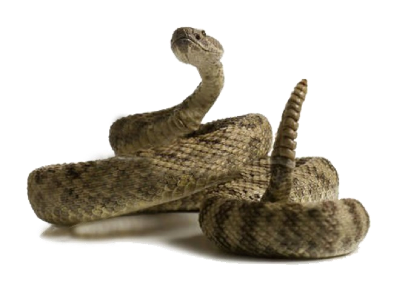 sert or woods, depending on where you live) you either wear snake proof boots or snake gaiters over your own thick leather boots, but what about Fido? Unfortunately there are no such products for canines, but even if there was, you might have a hard time convincing your pooch to wear them. So what can you do to keep your dog safe from snake bite? Check out rattlesnake avoidance training! sert or woods, depending on where you live) you either wear snake proof boots or snake gaiters over your own thick leather boots, but what about Fido? Unfortunately there are no such products for canines, but even if there was, you might have a hard time convincing your pooch to wear them. So what can you do to keep your dog safe from snake bite? Check out rattlesnake avoidance training!
"Prevention is your number one line of defense in protecting your dogs from venomous snakes. When dogs and their owners go hiking, camping, or to the park where dogs go off leash, this training teaches them to be fearful of the rattlesnake. It also protects the people as well, as the dog becomes an alert system. This training has proven to be an effective tool in teaching rattlesnake avoidance to all dogs from Great Danes to Chihuahuas," explains John Potash, co-founder and co-owner of Get Rattled.
Get Rattled is a unique training clinic designed specifically to teach dogs on rattlesnake avoidance. The clinic has been in business for 14 years and has successfully trained more than 5,000 dogs. Potash is licensed by the Nevada Department of Wildlife and has 24 years of experience working with venomous snakes and wildlife in areas of animal control, wildlife rescue, and public education. He works with skilled dog trainer Willie J. Stevens Jr. who has more than 20 years of experience training and judging pointing dogs. The training is held at Olive Hills Kennels in Knights Landing, California. If you live in a different state that is known to have a problem with snakes, ask around or search cyberspace for a similar training program near you.
But what happens if your beloved canine gets bitten despite your best efforts to protect him or her? Dogs are usually bitten on their front limbs, neck, head, or face so look for bleeding and severe swelling in those areas. A dog will often act as though something is bothering them by rubbing or licking the affected area. After some time, the venom may produce nausea, vomiting, and the dog can seem lethargic. If you see a snake bite happen or notice these symptoms, keep your dog calm and get to a vet right away.
 If your vet determines that your dog has been bitten by a rattlesnake, he or she can administer an anti-venom shot. Veterinarians in areas that are experiencing higher than usual incidences of snake bit in dogs also recommend a vaccine booster shot every six months. The vaccine is important not only because it can help limit the damage done by snakebite, but also because it costs far less than the anti-vemon. Although the vaccines cannot prevent a dog from suffering a snakebite, and they aren’t effective against all snakes found in all states, vets have reporting seeing plenty of dogs who are alive because they received the vaccine booster. The vaccine is effective against bites from western rattlesnakes and timber rattlesnakes, but not eastern rattlesnakes or water moccasins. If your vet determines that your dog has been bitten by a rattlesnake, he or she can administer an anti-venom shot. Veterinarians in areas that are experiencing higher than usual incidences of snake bit in dogs also recommend a vaccine booster shot every six months. The vaccine is important not only because it can help limit the damage done by snakebite, but also because it costs far less than the anti-vemon. Although the vaccines cannot prevent a dog from suffering a snakebite, and they aren’t effective against all snakes found in all states, vets have reporting seeing plenty of dogs who are alive because they received the vaccine booster. The vaccine is effective against bites from western rattlesnakes and timber rattlesnakes, but not eastern rattlesnakes or water moccasins.
Not all dog owners need to worry about vaccinating their pet, especially if your furry family member is primarily an indoor animal. But if Rover lives outside, like a hunting dog, or if your pet tends to wander around or is your hiking companion, talk to your local veterinarian about getting the vaccine.
Sunday, May 18 2014
It's rattlesnake season again! Most people fear those words, but a few actually relish this time of year. Are they crazy? Well, not exactly. Some folks have a job that involves tracking and catching snakes for research or preservation.
Take, for example, Ann Stengel in Sheffield, Massachusetts. Ms Stengel is a UMass Amherst doctoral candidate out to save the timber rattlesnake in New England. It turns out that the rattlesnake populations are endangered in that region. The largest population left in Massachusetts—and possibly in New England—is found in Berkshire County. Human incursion into habitat and malicious killing of the snakes have greatly disturbed their numbers. And given that female snakes only reproduce once every three to five years and 80 percent of offspring can be expected to die in the first year, the snakes are slow to rebuild depleted populations.
In the name of science, people like Stengel take newborn snakes into captivity for a year or a year and a half, then release them near their den site with the hope that they adapt back into the wild. Some do and some don't. The more successful this project becomes, the more people who find rattlers fearsome will object to it. In response, Ms. Stengle points out that snakes are good for rodent control, and that to date no one in Massachusetts has ever died of a rattlesnake bite. In fact, bites are extremely rare as timber rattlesnakes, the species found in the Berkshires, are not very aggressive.
A bride-to-be in El Dorado County, California wishes the rattlers in her area were not aggressive. Instead of marching down the aisle to say "I Do" Macee Whitton found herself in the hospital on her wedding day. A week before her Big Day, she was outside with her dogs and a rattlesnake bit her on the ankle. Despite getting bags of anti-venom at a nearby medical center, the poison kept traveling through her body. She had a lengthy hospital stay and it took weeks to recover. Her wedding has been rescheduled.
According to the California Poison Control Center, most bites occur between April and October when snakes and humans are most active outdoors. The vipers usually den from late October to early April. Their body temperature will get down to 40 degrees. They lose very little body weight because they shut down metabolically. A female rattler is pregnant for more than a year before giving birth to eight to 12 live little snakes. You might think the mother rattler then slithers off and leaves the little ones to fend for themselves, but researcher shows that the mother remains with her young until she leads them to the family den at the end of fall. There, the little ones, their mother and 30 to 50 other snakes will disappear deep into the ground below the frost level to sleep away the winter.
Once the snakes emerge from hibernation at this time of year, they have a kind of social life. They often use the same basking areas, and are particularly fond of south-facing rocky slopes. During the warm months snakes will travel— males up to four miles and non-pregnant females about two miles. But they always return to the same den. An adult rattler can live for 45 years if it avoids predators such as humans and red-tailed hawks.
The best thing you can do when in rattlesnake country is not to avoid the great outdoors, but to be prepared by wearing snake gaiters or snake proof boots. And don't ever let your guard down. Keep an eye out, be careful of where you sit, and don't reach into blind areas under rocks or wood piles where rattlesnake hang out.
|